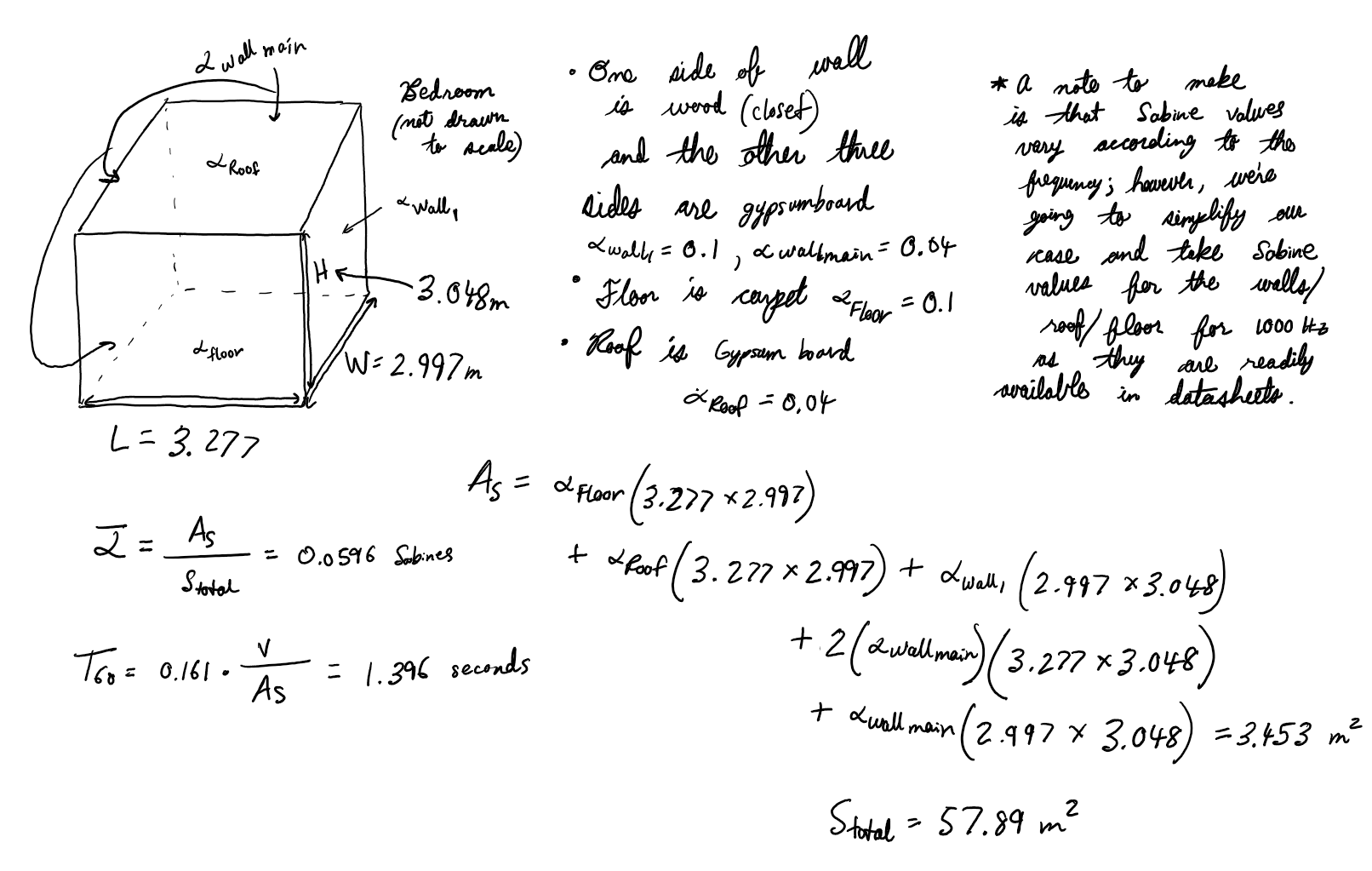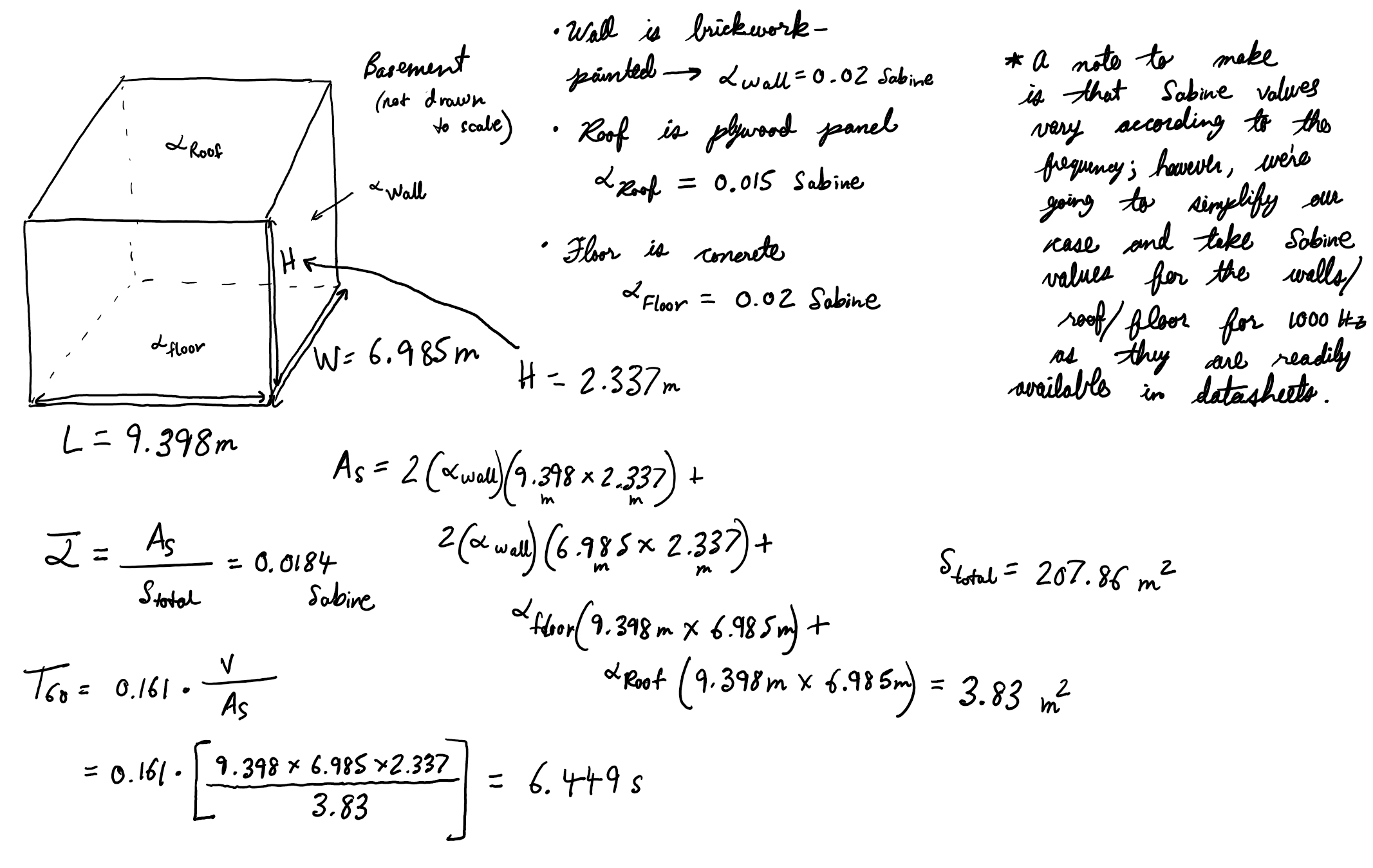Room Acoustics and Language Understanding
Impact of room acoustics on the clarity and understanding of spoken language in Abjad and Latin scripts
The Challenge: How do different room environments affect our ability to understand spoken language? This question becomes particularly fascinating when we consider languages with fundamentally different phonetic structures—like English (Latin script) and Urdu (Abjad script). In this acoustics research project, I explored how room reverberation times and acoustic characteristics impact speech intelligibility across these distinct linguistic systems.
The Innovation: Rather than focusing solely on traditional acoustic measurements, this project uniquely combined room acoustics analysis with phonetic science, examining how different room environments affect specific phonetic elements that are crucial for language comprehension.
Table of Contents
- The Research Question
- Methodological Framework
- Technical Implementation
- Experimental Design
- Results and Analysis
- Key Findings
- Technical Challenges and Solutions
- Project Impact and Applications
- Future Research Directions
The Research Question
Core Hypothesis: Room acoustics significantly impact speech intelligibility, but the magnitude and nature of this impact varies between languages with different phonetic structures.[5]
Why This Matters: Understanding how room acoustics affect different languages has profound implications for:
- Architectural Design: Optimizing spaces for multilingual environments
- Communication Systems: Designing audio systems for diverse linguistic communities
- Educational Settings: Creating optimal learning environments for language instruction
- Healthcare: Ensuring clear communication in medical facilities serving diverse populations
The Language Pair: English (Latin script) vs. Urdu (Abjad script)
- English: Stress-timed language with clear syllable boundaries
- Urdu: Syllable-timed language with different phonetic emphasis patterns
- Phonetic Differences: Vowel length, consonant clusters, stress patterns
Methodological Framework
Acoustic Analysis
Reverberation Time (T60) Measurement:
- Definition: Time for sound pressure level to decrease by 60 dB after source cessation[6]
- Practical Implementation: Used T30 measurements (30 dB drop) due to ambient noise constraints
- Calculation Method: Extrapolation from T30 to estimate T60 values
- Validation: Cross-referenced calculated vs. measured values
Room Characterization:
- Material Analysis: Sabine absorption coefficients for all surfaces
- Geometric Considerations: Room dimensions and volume calculations
- Environmental Factors: Ambient noise levels and temperature conditions
Phonetic Investigation
International Phonetic Alphabet (IPA) Analysis:
- English Phonemes: /h/, /a/, /ʊ/, /ɪ/, /z/, /j/, /ɔ/, /r/, /d/, /e/
- Urdu Phonemes: /ɐ/, /p/, /k/, /a/, /d/, /ɪ/, /n/, /ɛ/, /s/, /h/
- Spectrogram Analysis: Visual representation of phonetic elements across environments
- Frequency Domain Analysis: How different frequency ranges are affected by room acoustics[3]
Key Phonetic Differences:
- Vowel Length: English has more variable vowel durations
- Consonant Clusters: Different patterns between languages
- Stress Patterns: English stress-timed vs. Urdu syllable-timed
- Phonetic Inventory: Distinct sound sets with different acoustic properties
Comparative Language Study
Control Environment Analysis:
- Baseline Measurements: Direct microphone recording without room effects
- Phonetic Clarity: Establishing reference spectrograms for both languages
- Frequency Response: Understanding natural speech characteristics
Room Environment Comparison:
- Bedroom Acoustics: Moderate reverberation (T60 ≈ 2.4 seconds)
- Basement Acoustics: High reverberation (T60 ≈ 6.1 seconds)
- Intelligibility Assessment: Subjective and objective measures
Technical Implementation
Equipment and Software
Audio Recording System:
- Blue Yeti Microphone: Professional USB condenser microphone
- Control Settings: Low gain, cardioid mode for direct field emphasis
- Room Settings: 50% gain, omnidirectional mode for environmental capture
- Positioning: Consistent microphone placement across all environments
Measurement Tools:
- NIOSH SLM iOS App: Reverberation time measurement
- Sonic Visualizer: Spectrogram generation and analysis
- Engineering Toolbox: Sabine coefficient reference database
Analysis Software:
- Spectrogram Generation: Visual representation of phonetic elements
- Frequency Analysis: Quantitative assessment of acoustic changes
- Statistical Processing: Data validation and error analysis
Room Characterization
Bedroom Environment:
- Walls: Gypsum board (α = 0.04 Sabine)[2]
- Floor: Carpet (α = 0.1 Sabine)[2]
- Ceiling: Gypsum board (α = 0.04 Sabine)[2]
- Closet: Wood surface (α = 0.1 Sabine)[2]
- Calculated T60: 1.396 seconds
- Measured T30: 1.202 seconds → Estimated T60: 2.404 seconds
Basement Environment:
- Walls: Painted brickwork (α = 0.02 Sabine)[2]
- Floor: Painted concrete (α = 0.02 Sabine)[2]
- Roof: Plywood panel (α = 0.015 Sabine)[2]
- Calculated T60: 6.449 seconds
- Measured T30: 3.066 seconds → Estimated T60: 6.132 seconds
Data Collection Protocol
Standardized Procedure:
- Ambient Noise Measurement: Baseline environmental conditions
- Control Recording: Direct microphone capture without room effects
- Room Recording: Identical speech samples in each environment
- Spectrogram Generation: Visual analysis of phonetic elements
- Quantitative Analysis: Reverberation time and frequency response
Quality Control:
- Consistent Speech Rate: Maintained natural speaking pace
- Volume Control: Standardized recording levels
- Positioning: Fixed microphone and speaker positions
- Environmental Stability: Controlled temperature and humidity
Experimental Design
Room Selection
Strategic Environment Choice:
- Bedroom: Moderate reverberation, typical living space
- Basement: High reverberation, challenging acoustic environment
- Control: Direct recording for baseline comparison
Acoustic Diversity:
- Reverberation Range: 1.2 to 6.1 seconds T60
- Material Variety: Different surface types and absorption coefficients
- Geometric Differences: Varying room dimensions and shapes
Language Sampling
English Test Phrases:
- Phonetic Coverage: Representative sample of English phonemes
- Stress Patterns: Natural stress-timed speech
- Intelligibility Focus: Common words and phrases
Urdu Test Phrases:
- Abjad Characteristics: Consonant-heavy phonetic structure
- Syllable Timing: Natural syllable-timed speech patterns
- Cultural Relevance: Meaningful phrases for native speakers
Measurement Strategy
Multi-Dimensional Analysis:
- Objective Measures: Reverberation time, frequency response
- Subjective Assessment: Perceived intelligibility
- Visual Analysis: Spectrogram comparison
- Statistical Validation: Error analysis and confidence intervals
Results and Analysis
Reverberation Time Measurements
Calculated vs. Measured Values:
| Environment | Calculated T60 (s) | Measured T30 (s) | Estimated T60 (s) | Error (%) |
|---|---|---|---|---|
| Bedroom | 1.396 | 1.202 | 2.404 | 72.2% |
| Basement | 6.449 | 3.066 | 6.132 | 4.9% |
Key Observations:
- Basement Accuracy: Excellent agreement between calculated and measured values
- Bedroom Discrepancy: Significant difference due to unaccounted factors
- Ambient Noise Impact: T30 measurements affected by 27 dB background noise
Experimental Setup and Data Visualization




Phonetic Impact Analysis
Frequency Domain Effects:
- Lower Frequencies: Strengthened and longer reverberation in both languages
- Higher Frequencies: More rapid decay, reduced intelligibility
- Language-Specific Patterns: Different phonetic elements affected differently
English Phonetic Analysis:
- Vowel Clarity: Longer vowels maintain intelligibility better
- Consonant Clarity: Plosives (/p/, /t/, /k/) affected by room acoustics
- Stress Patterns: Syllable stress helps maintain word boundaries
Urdu Phonetic Analysis:
- Consonant-Heavy Structure: More affected by high reverberation
- Vowel System: Shorter vowels more susceptible to acoustic degradation
- Syllable Timing: Less stress variation makes timing crucial
Language Comparison
Intelligibility Rankings:
- English in Bedroom: Best overall intelligibility
- English in Basement: Moderate intelligibility maintained
- Urdu in Bedroom: Good intelligibility with some degradation
- Urdu in Basement: Most challenging for comprehension
Key Findings:
- Stress-Timed Advantage: English’s stress patterns provide natural redundancy[4]
- Syllable-Timed Challenge: Urdu’s timing makes it more sensitive to reverberation
- Phonetic Inventory: Different sound sets respond differently to room acoustics[1]
Key Findings
Primary Conclusions:
-
Language Structure Matters: Stress-timed languages (English) show better intelligibility in high-reverberation environments compared to syllable-timed languages (Urdu)[4]
-
Frequency-Dependent Effects: Lower frequencies are strengthened and reverberate longer, while higher frequencies decay more rapidly
-
Vowel Length Significance: Longer vowels maintain intelligibility better than shorter vowels across all environments[1]
-
Stress Pattern Benefits: Languages with clear stress patterns (like English) provide natural redundancy that aids comprehension in challenging acoustic environments[4]
Engineering Implications:
- Room Design: Spaces for multilingual use should optimize for syllable-timed languages
- Audio Systems: Different equalization strategies may be needed for different languages
- Educational Settings: Language instruction rooms should consider phonetic characteristics
Technical Challenges and Solutions
Challenge 1: Ambient Noise Interference
- Problem: 27 dB background noise affecting T60 measurements
- Solution: Used T30 measurements with extrapolation to T60
- Validation: Cross-referenced with calculated values
Challenge 2: Room Characterization Accuracy
- Problem: Significant discrepancy in bedroom calculations
- Solution: Identified unaccounted factors (furniture, air gaps)
- Learning: Real-world conditions often differ from theoretical models
Challenge 3: Phonetic Analysis Complexity
- Problem: Subjective assessment of intelligibility
- Solution: Combined objective measurements with spectrogram analysis
- Validation: Multiple analysis methods for comprehensive understanding
Challenge 4: Language-Specific Considerations
- Problem: Different phonetic structures require different analysis approaches
- Solution: Developed language-specific analysis protocols
- Outcome: More nuanced understanding of acoustic effects
Project Impact and Applications
Immediate Applications:
- Architectural Acoustics: Design guidelines for multilingual spaces
- Audio Engineering: Language-specific audio system optimization
- Educational Technology: Classroom design for language instruction
- Healthcare Communication: Medical facility design for diverse populations
Research Contributions:
- Methodology Development: Novel approach combining acoustics and phonetics
- Language-Specific Analysis: Framework for studying different linguistic systems
- Practical Guidelines: Real-world applications for acoustic design
Educational Value:
- Interdisciplinary Learning: Integration of acoustics, linguistics, and engineering
- Practical Skills: Equipment operation, data analysis, technical writing
- Research Methodology: Experimental design and statistical analysis
Future Research Directions
Expanded Language Study:
- Language Families: Indo-European, Austronesian, Afro-Asiatic comparisons
- Phonetic Diversity: Languages with different phonetic inventories
- Cultural Context: Impact of cultural communication patterns
Advanced Acoustic Analysis:
- Custom Equipment: Development of specialized measurement tools
- Real-Time Analysis: Dynamic assessment of acoustic changes
- Machine Learning: Automated intelligibility prediction
Practical Applications:
- Virtual Reality: Acoustic modeling for immersive environments
- Telecommunications: Language-optimized audio compression
- Assistive Technology: Hearing aid optimization for different languages
Methodological Improvements:
- More Environments: Gymnasiums, “acoustically dead” rooms
- Larger Sample Sizes: Multiple speakers per language
- Longitudinal Studies: Long-term acoustic effects on language learning
Key Innovation: This project uniquely combined room acoustics analysis with phonetic science, examining how different room environments affect specific phonetic elements crucial for language comprehension. The comparative approach between stress-timed (English) and syllable-timed (Urdu) languages provided insights into how linguistic structure influences acoustic intelligibility.
References
[1] Bradlow, A. R., Torretta, G. M., & Pisoni, D. B. Intelligibility of normal speech I: Global and fine-grained acoustic-phonetic talker characteristics. Speech communication. Volume 20. Issue 3. pp. 255–272. 1996.
[2] Engineering ToolBox. Room Sound Absorption - Sound Absorption Coefficient. 2003. [https://www.engineeringtoolbox.com/accoustic-sound-absorption-d_68.html](https://www.engineeringtoolbox.com/accoustic-sound-absorption-d_68.html)
[3] Interactive IPA Chart. Retrieved May 11, 2020, from [https://www.ipachart.com/](https://www.ipachart.com/)
[4] Hawkins, S., & Warren, P. Phonetic influences on the intelligibility of conversational speech. Journal of Phonetics. Volume 22. Issue 4. pp. 493–511. 1994.
[5] Rakerd, B., Hunter, E. J., Berardi, M., & Bottalico, P. Assessing the Acoustic Characteristics of Rooms: A Tutorial with Examples. Perspectives of the ASHA special interest groups. Volume 3. Issue 19. pp. 8-24. 2018.
[6] Reverberation Time Measurements. Retrieved May 10, 2020, from [http://www.larsondavis.com/support/reverberation-time-in-room-acoustics](http://www.larsondavis.com/support/reverberation-time-in-room-acoustics)
This project was completed as part of EM 451 (Engineering Acoustics) at Iowa State University.